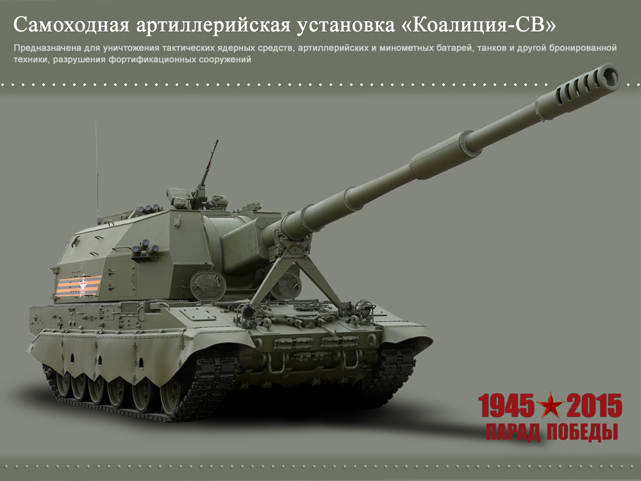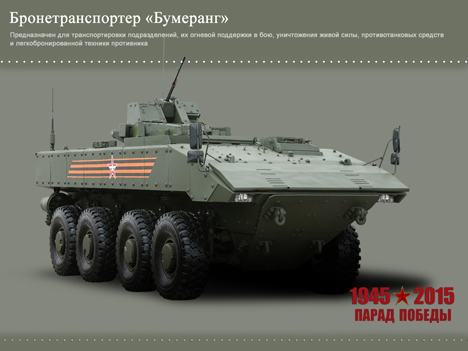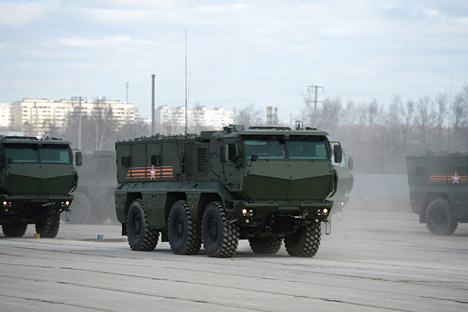
May 9 parade in Moscow promises to be most ambitious in history. Source: Grigory Sysoev / RIA Novosti
In accordance with recently established tradition, military parades will once again be at the heart of the Victory Day celebrations in Russia in 2015. Apart from Moscow, which holds its famous parade on Red Square, more than 150 Russian cities and towns will put together their own parades. According to Russian Defense Minister Sergei Shoigu, about 85,000 troops are to take part in the events.
This year's Moscow parade will be the largest since the dissolution of the Soviet Union in 1991. "Over 15,000 troops – including representatives of foreign countries who will form 10 separate detachments – will take part in the parade,” general Shoigu revealed in an interview. "Moreover, we are planning to include 1.5 times more hardware than last year, which is about 200 vehicles in total.”
The parade in the Russian capital will include both historical and modern parts. The first to march through Red Square will be servicemen dressed in World War II-era uniforms, followed by a procession of historical military hardware, including the symbolic Soviet T-34 tank as well as the SU-100 tank destroyer.
Among the troops taking part in the parade will be cadets and students of higher military educational institutions, pupils from the Suvorov and Nakhimov military schools and other cadet corps, and military men of the Western military district, along with EMERCOM emergency services, Interior Ministry and FSB personnel.
The parade will also include a flypast, which promises to be just as grand. The spectators will see 143 aircraft in total – twice as many as last year – including Sukhoi Su-27 and Su-34 fighters, Mikoyan MiG-31 interceptors, the Yakovlev Yak-130 lead-in fighter trainer, Antonov An-124-100 and Ilyushin Il-76 strategic airlifters, A-50 airborne early warning and control aircraft, Tupolev Tu-22M3, Tu-95 and Tu-160 strategic bombers, and also Mil Mi-8, Mi-26, Mi-28 and Kamov Ka-52 helicopters, as well as the Ansat-U trainer helicopter.
But this year's parade is special not only in terms of the sheer number of people and hardware involved. It will also set a record for the amount of new equipment presented to the public for the first time, with a whopping total of 70 brand-new vehicles to be revealed.
People gathered on Red Square will be able to catch a glimpse of Msta-S self-propelled howitzers, Iskander short-range ballistic missile systems, Tigr and Typhoon multipurpose infantry mobility vehicles, BTR-82A APCs, T-90 tanks, Buk-M2 and Tor-M2U surface-to-air missile systems, Pantsir-S1 anti-aircraft artillery and missile systems and S-400 anti-aircraft system launch vehicles.
The upcoming Red Square parade will have another unique feature: Unlike previous events which only showcased hardware already in mass production and in service, this year's parade will see participation by a number of prototypes.
The new vehicles in question are Armata tanks, Kurganets-25 IFV modular platforms and Bumerang wheeled APCs. The Armata was only unveiled by the Ministry of Defense on May 4.
“This is a completely new weapon, a breakthrough in tank design,” military historian Alexander Sukhanov told RBTH. “Russian tank designers have said goodbye to Soviet heritage and what we now see is an entirely different concept. The small size has taken a backseat, giving way to another approach, namely that of strong armor designed to save lives. It is already evident that these new vehicles represent a tremendous change in the approach to Russian tank design,” he added.
The biggest parades involving hardware outside Moscow will take place in Kaliningrad, Sevastopol and St. Petersburg. The St. Petersburg parade will also showcase the Bal and Bastion coastal defense systems, Project 877 Paltus submarines, Bora and Samum hoverborne guided missile corvettes and several destroyers.
The parade in Yekaterinburg, the central city of the Urals, will involve 2,000 servicemen and 80 vehicles, comprising T-72B tanks, Iskander missile systems, as well as Buk and S-300 anti-aircraft systems. The TOS-1 multiple rocket launcher will also make an appearance – a first for the city.
In Siberia, people attending the parade in Novosibirsk will have the first opportunity to see the Yars missile systems. Also on show will be Gusar light armored vehicles, Tigr IMVs, Uragan multiple rocket launchers and Iskander-M missile systems.
As for the Russian Far East, the biggest parade there will be held in Khabarovsk (over 1,900 troops and 100 vehicles). Here, people will also witness the performance of a selection of World War II-era hardware, including MS-1, IS-3 and T-34 tanks. And right after the historical part of the parade, modern vehicles, including Pantsir-S and Iskander systems, will be showcased.
In Vladivostok, the parade will be somewhat more modest (1,300 servicemen, 30 vehicles and five ships), but it will be the only place to see Redut coastal defense systems. S-300 missile systems will also take part in the local event.
Т-14 (Armata)

The T-14 Armata tank. Source: Mil.ru
The Т-14 tank was developed using the Armata platform. It will enter the army as the new main battle tank for Russian ground forces. A key feature of the Т-14 is the unmanned turret – all three crew members will sit in a special capsule at the base of the tank. The new vehicle will have a 125 mm 2A82A cannon, equipped with automatic loading, a 30 mm twin-barreled machine-gun, and also 12.7 mm automatic cannon.
The technical group using the Armata platform is designed according to the modular principle, so that repairs can be made simply by replacing components with new ones. This dramatically simplifies battlefield repairs. Furthermore, all new armored vehicles can be delivered to the battlefield by airplane or train and due to the latest onboard equipment are integrated into a unified information space for automated systems management of troops and weaponry, which means that they are capable of conducting network-centric warfare.
Coalition-SV

This self-propelled unit, which will replace the ACS MSTA-S, is also designed using the Armata platform. The Coalition has an unmanned combat compartment with an automated pneumatic loading system, which ensures a high rate of fire. The ACS is capable of hitting ground targets at a distance of 70 km while in high firing rate mode. The new loading technology enables quick preparation for firing and can also change its deployment within a minute.
Kurganets-25

The Kurganets-25 armored personnel carrier. Source: Mil.ru
The Kurganets-25 is a universal long-range medium class tracked platform, which is intended to be the basis of a mechanized infantry combat vehicle, landing vehicle, tracked armored personnel carrier and anti-tank self-propelled unit. It will be the first Russian infantry combat vehicle in which the infantry will be separated from the module with the weaponry and munitions. Armaments include a 30 mm automatic cannon 2А42, paired with a 7.62 mm machine gun and the Kornet-EM anti-tank missile system.
Bumerang

The Bumerang vehicle. Source: Mil.ru
The Bumerang is a medium class wheeled unified platform, which will be the basis for a whole range of combat and auxiliary vehicles (mechanized infantry vehicles, armored vehicles, wheeled tanks, and also the chassis for special purpose equipment). The Bumerang is an 8x8 wheeled vehicle with a remotely controlled weapons module and ceramic armor. When equipped as a light or medium vehicle it can cross water obstacles.
Typhoon

A Typhoon armored vehicle is at Alabino base
during a joint training of soldier formations and mechanized units for
the Victory Parade, April 22. Source: Alexey Filippov / RIA Novosti
A mine-resistant ambush-protected vehicle, the Typhoon class comes as a 6×6 and 4×4 wheeled vehicle for transporting infantry. The vehicle is guaranteed to withstand an explosion beneath its wheels or body from a charge the equivalent of 8 kg of explosives. The combined steel and ceramic armor can withstand armor-penetrating B-32 bullets.
The vehicle has the CICS GALS-D1M monitoring system for observing and regulating the engine’s operation, calculating the vehicle’s roll, slope of the road, and speed, as well as determining its location.
All rights reserved by Rossiyskaya Gazeta.
Subscribe
to our newsletter!
Get the week's best stories straight to your inbox